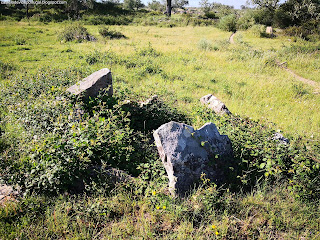

Belonging to the so-called "Megalithic Necropolis of the Coureleiros", the "Anta dos Coureleiros III" is located in an isolated way in an area of pasture and cork oaks in the vicinity of a mountain of the parish of Santiago Maior.
Built between the Neolithic and the Chalcolithic, this megalithic monument had a sepulchral chamber with a regular polygonal plan constituted by seven granite steles, all of them split at the height of the base and displaced from its original position.
As far as the primitive open aisle is concerned, only four small studs have come down to us, two in each of the two rows.
As for the mamoa - or tumulus -, it is partially destroyed, like most of this entire funerary structure. [AMartins]
Built between the Neolithic and the Chalcolithic, this megalithic monument had a sepulchral chamber with a regular polygonal plan constituted by seven granite steles, all of them split at the height of the base and displaced from its original position.
As far as the primitive open aisle is concerned, only four small studs have come down to us, two in each of the two rows.
As for the mamoa - or tumulus -, it is partially destroyed, like most of this entire funerary structure. [AMartins]
Pertencendo à denominada "Necrópole Megalítica dos
Coureleiros", a "Anta dos Coureleiros III" está localizada de
modo isolado numa zona de pastagem e sobreiros nas imediações de um monte da
freguesia de Santiago Maior.
Edificado entre o Neolítico e o Calcolítico, este monumento megalítico possuía câmara sepulcral de planta poligonal regular constituído por sete esteios graníticos, todos eles partidos à altura da base e deslocados da sua posição original.
No que diz respeito ao primitivo corredor aberto a nascente chegaram até nós apenas quatro esteios de pequenas dimensões, dois em cada uma das duas fiadas.
Quanto à mamoa - ou tumulus -, ela encontra-se parcialmente destruída, tal como a maior parte de toda esta estrutura funerária. [AMartins]


